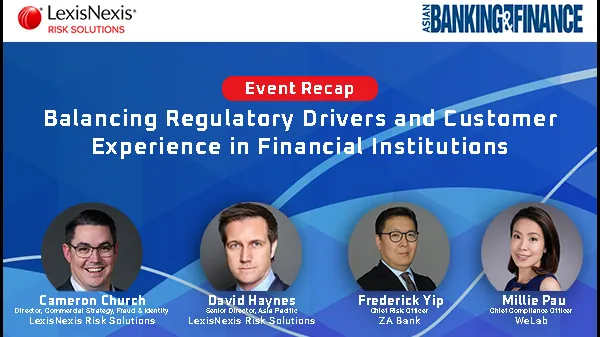
Hong Kong finance experts on optimizing customer journeys whilst mitigating fraud risks
LexisNexis Risk Solutions and Asian Banking & Finance's latest webinar discussed ways on how the most tech-savvy banks are safeguarding their clients' data whilst not compromising services.
As Hong Kong clients increasingly pivot towards digital solutions to meet their financial needs, financial institutions face a tough balancing act of mitigating fraud and cybercrime risks whilst providing the most seamless and convenient customer journey.
Experts and digital finance leaders in Hong Kong discussed how banks and other financial institutions will be able to win big amidst whilst combatting security risks and providing the optimal customer experience in the webinar “Balancing Regulatory Drivers and Customer Experience in Financial Institutions,” co-hosted by LexisNexis® Risk Solutions and Asian Banking & Finance on 22 July.
Financial institutions’ weakest link in terms of securing their services digitally lies in the biggest non-digital element involved: that is, the customer.
“If we look at common digital fraud challenges, increasingly we're seeing the customer becoming the weakest link in terms of cybersecurity and fraud,” David Haynes, senior director for financial crime compliance and fraud and identity solutions at LexisNexis Risk Solutions APAC, told the webinar attendees during the titular presentation.
“There are numerous reasons why the customer is the weakest point here-- from phishing attempts, malware, account takeover threats, social engineering, phone porting, among the long list of reasons why customers are being targeted,” Haynes noted.
To protect the digital identity of their clients in real time, Haynes recommended that financial institutions onboard threat metrics technology. This involves collecting data, analyzing huge volumes of data through technology and devices, all done within a fraction of a second--thus allowing banks to either identify false positives or false negatives in terms of every interaction that's happening via their app, or on their website.
Tech-driven ecosystems and the anti-fraud tightrope
Financial regulators in Asia tend to view technological development in financial services as a way of really growing their economies and providing better outcomes for their customers, Haynes also noted in his presentation.
Virtual banks in Hong Kong are notedly an exceptional example of this dynamic. “This is really helping the sector to achieve a higher level of service and embrace the enormous opportunities brought about by the conversions of banking and technology. And that's obviously improving the quality of banking products available to customers, and so on,” Haynes said.
This is an objective that Hong Kong’s first virtual-only lender ZA Bank took to heart, according to Frederick Yip, chief risk officer of ZA Bank.
“One major policy objective of virtual banks is to promote financial inclusion in Hong Kong. And this can hardly be done by saving alone,” Yip said.
According to Yip, ZA Bank is trying to build a unique, tech-driven ecosystem that meets the different aspects across users' lifestyle: coverage insurance, food and beverage, travel, shopping, telecommunication, and public utilities, amongst others.
Data, alongside partnerships with other market players, will be key to building the ecosystem, said Yip. However, virtual banks still need to overcome five key risk areas: technology, operations, credit liquidity, anti-money laundering and character financing.
“We need to overcome the lack of confidence of the cost and trust of consumers because we have no physical branch,” Yip said, later adding that virtual banks also need to ensure that their bank apps and technology are reliable and resilient to cyber security attacks in the area of operations.
To strike the balance between optimizing risk management and enhancing the customer experience, homegrown virtual-only lender WeLab Bank applied an e-KYC solution in their services, whilst also equipping it with the leading analytic technology and machine learning capability alongside their fraud prevention solutions.
“The beauty of being a virtual bank is that all offerings are online, so customers do not need to go to our branches or offices to do identity, due diligence,” said Millie Pau, chief compliance officer at WeLab Bank, participating in the webinar’s panel discussion. “And powered by technology, automation and digitalization ability we can easily accomplish and slim down our operation model to address our customer pain points with risk governance and control and data all at once.”
One key example on how WeLab Bank has kept itself atop of the anti-fraud but customer-driven tightrope is in its account opening process. During the process, WeLab Bank accesses a database that immediately checks the identity in the customer’s Hong Kong ID card and matches it with the identity of the customer applying--all done in as fast as three minutes.
This showcases a perfect mix of convenience for the customer whilst having anti-fraud security measures in place. Pau said that WeLab Bank’s onboarding process for new customers can take as fast as less than three minutes thanks to this.
True Cost of Fraud™
Having more anti-cybercrime and identity security checks in place is especially a necessity for financial institutions in Hong Kong, where the LexisNexis True Cost of Fraud study found they are about four times more impacted by fraud than their retail and e-commerce counterparts.
Financial institutions are more heavily hit because they still play a role in the payment chain of retail and e-commerce spaces--for example, through the chargeback process and customer refund process, said Cameron Church, director, commercial strategy, fraud & identity, at LexisNexis Risk Solutions.
“Identity related fraud is particularly troubling for financial institutions representing just under half of their fraud losses. This is just under double the level compared to retail and e-commerce merchants,” he said.
Organizations who kept their operations secure whilst minimizing security-related inconveniences for their customers are those that applied a multi-layered approach.
“Merchants and financial services firms that use multi-layered approaches involving passive digital transaction risk mitigation solutions that are integrated with cybersecurity and digital customer experience can more effectively detect and prevent fraud and minimize customer friction and lower the cost of fraud,” Church said.
LexisNexis Risk Solutions also recommends the multi-layered approach, which basically leverages various authentication processes, whether it be passive authentication that doesn't require any customer friction, or adding a small amount of customer friction depending on the risk.
Forming industry alliances are also a key part of this approach, according to Church.
“Cybersecurity, and digital customer experience operations must be integrated with fraud processes and seek industry alliances,” Church said. “We're suggesting not only working with technology providers that can enable that industry alliance, but also working and identifying your own industry alliance within the region or within the market. They can be quite powerful in terms of identifying new trends together and helping to prevent those new scale fraud attacks.”
For their part, LexisNexis Risk Solutions has introduced identity and linking analysis, which are able to spot trends through multiple devices, to enhance the security whilst refining the services of their financial institution partners.
“The technology enables banks to identify the true location of their customers regardless of whether they're using a VPN or some other kind of identity masking technology,” Haynes said. “The technology also enables banks to recognize good behavior versus bad behavior through behavioral biometrics and behavioral intelligence. And it's also enabling banks to spot bots, malware and other forms of threat intelligence coming into the network.”
To learn more about the 2021 True Cost of Fraud™ APAC, please download the full report HERE.





![Cross Domain [Manu + SBR + ABF + ABR + FMCG + HBR + ]](https://cmg-qa.s3.ap-southeast-1.amazonaws.com/s3fs-public/styles/exclusive_featured_article/public/2025-01/earth-3537401_1920_4.jpg.webp?itok=WaRpTJwE)
![Cross Domain [SBR + ABR]](https://cmg-qa.s3.ap-southeast-1.amazonaws.com/s3fs-public/styles/exclusive_featured_article/public/2025-01/pexels-jahoo-867092-2_1.jpg.webp?itok=o7MUL1oO)








 Advertise
Advertise






